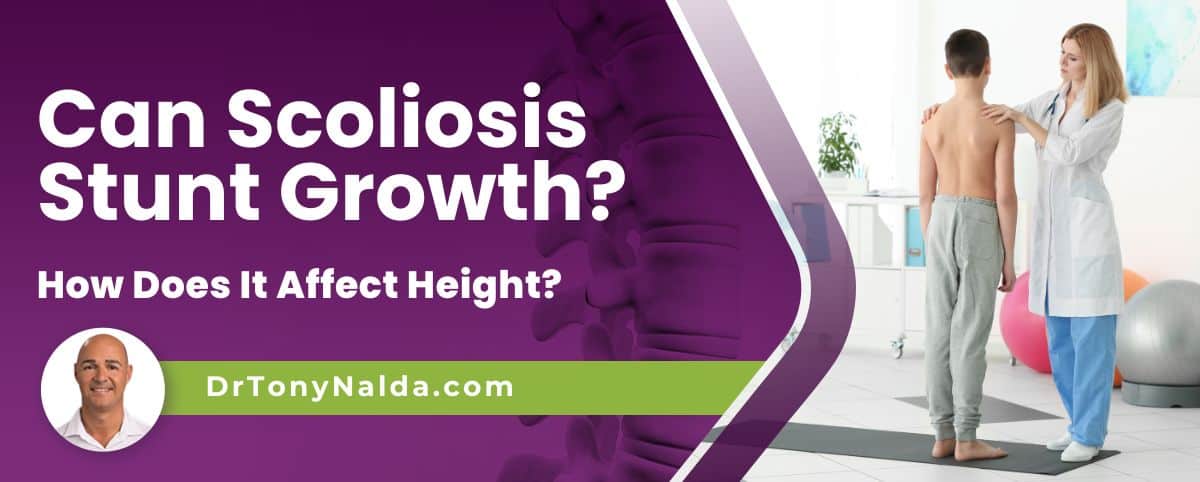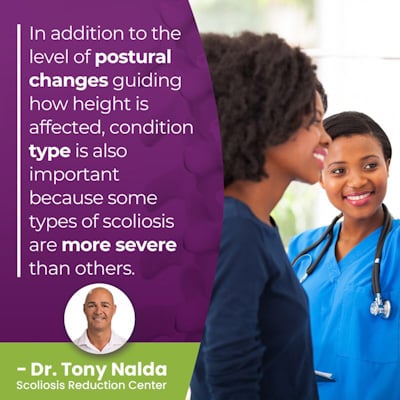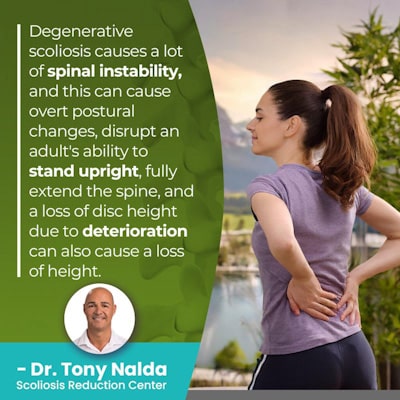Can Scoliosis Stunt Growth? How Does It Affect Height?

Scoliosis can cause some surprising effects, and the main effect in children involves postural changes caused by a loss of the spine's healthy curves and the condition's uneven forces. Scoliosis severity is a key factor that shapes the type of symptoms a patient's likely to experience, and a loss of vertical trunk height can be one.
The effects of scoliosis can be felt throughout the body: not just in and around the spine. Scoliosis causes postural changes that can shift the body's center of gravity and make it difficult to stand upright, causing a loss of trunk height, but it's not associated with preventing growth.
Each case of scoliosis is unique, so before we get to the specifics of how it affects height, let's explore the characteristics that make it vary from patient to patient.
Table of Contents
Cobb Angle and Condition Severity
If a scoliosis diagnosis is reached, an unnatural side-to-side spinal curvature has developed, and the spine doesn't just bend unnaturally to the side, it also rotates, and the rotational component is what makes scoliosis a 3-dimensional condition.
In addition to the rotational component that has to be present, the size of a scoliotic curve has to be a minimum of 10 degrees to be considered a true scoliosis.
A patient's Cobb angle measurement is determined during X-ray by drawing a series of lines from the tops and bottoms of the vertebrae at the apex of the curve; these are the most unnaturally-tilted vertebral bodies, and the resulting angle is expressed in degrees.
When the spine's healthy curves are in place, its vertebrae are aligned in a straight and neutral position as they should be, and when an unnatural spinal curvature develops, the spine becomes misaligned and off balance.
The higher a patient's Cobb angle measurement, the further out of alignment the spine is, and the more severe the condition:
- Mild scoliosis: Cobb angle measurement of between 10 and 25 degrees
- Moderate scoliosis: Cobb angle measurement of between 25 and 40 degrees
- Severe scoliosis: Cobb angle measurement of 40+ degrees
- Very-severe scoliosis: Cobb angle measurement of 80+ degrees
Condition severity shapes treatment plans, and along with other key patient/condition variables, indicates the types of symptoms a patient is likely to experience.
So the more severe a condition is, the more uneven forces are being introduced to the body, and the more overt its effects tend to be.
No two cases of scoliosis are the same because they are shaped by a number of fluctuating variables: patient age, condition severity, type, and curvature location.
In addition there are multiple different curvature types and patterns that are also important.
As the condition's postural changes are what can affect a person's height the most, let's start there.
Postural Changes and Height
Scoliosis patients are all ages, but the condition is most commonly diagnosed during adolescence as adolescent idiopathic scoliosis, diagnosed between the ages of 10 and 18.
Postural changes are the main effect in children, and this is caused by the condition's uneven forces disrupting the body's overall symmetry, and as a progressive condition, scoliosis is virtually guaranteed to get worse over time, and as it does, so do its effects.
Postural changes become more overt as conditions become more severe, and common postural changes to expect with scoliosis can include:
- The head appearing uncentered over the torso
- Uneven shoulders
- Uneven shoulder blades
- The development of a rib cage arch
- Uneven hips
- Arms and legs hanging at different lengths
 Because scoliosis causes a loss of the spine's healthy curves, it shifts the body's center of gravity, also causing problems with balance, coordination, and gait.
Because scoliosis causes a loss of the spine's healthy curves, it shifts the body's center of gravity, also causing problems with balance, coordination, and gait.
As scoliosis causes the appearance of poor posture (asymmetry, slouching, and/or excessively leaning to one side), it makes it difficult to stand fully erect and extend the spine; as a structural spinal condition, scoliosis involves a structural abnormality within the spine itself.
With structural spinal conditions, no change in body position will alter an unnatural curve, so treatment has to address the underlying structural nature of scoliosis.
In addition to the level of postural changes guiding how height is affected, condition type is also important because some types of scoliosis are more severe than others.
Condition Type and Height
Condition type is important because there are both typical and atypical types that can affect the body differently and have different treatment needs.
The most common type of scoliosis to affect all ages is idiopathic scoliosis, meaning no single-known cause, and this accounts for approximately 80 percent of known cases, and the remaining 20 percent are associated with known causes and considered atypical: neuromuscular scoliosis, degenerative scoliosis, and congenital scoliosis.
Babies are born with congenital scoliosis due to a malformed spine that develops in utero, and cases of neuromuscular scoliosis and degenerative scoliosis are the condition types that tend to most-noticeably affect height.
In typical cases of scoliosis, curves bend to the right, away from the heart, but in atypical cases with known causes, they can bend to the left, towards the heart.
Neuromuscular scoliosis patients are generally the most challenging to treat because their conditions are severe.
Neuromuscular Scoliosis and Height
Neuromuscular scoliosis is caused by the presence of a larger neuromuscular condition such as cerebral palsy, spina bifida, and muscular dystrophy.
Neuromuscular conditions cause a disconnect between the brain and the muscles and connective tissues that support the spine, and this disrupts the spine's ability to maintain its natural curves, which is why they can be severe and affect height.
The severity of neuromuscular scoliosis is determined by the degree of muscle and nerve involvement, and when severe, it can cause patients to become nonambulatory and wheelchair bound: not that this is the same as losing actual inches of height, but it does affect a person's ability to stand upright unassisted and fully extend the spine.
Degenerative Scoliosis and Height
When it comes to degenerative scoliosis, this is another condition type known to cause a loss of vertical trunk height, and it's caused by the cumulative effect of certain lifestyle factors and natural age-related spinal degeneration.
Degenerative scoliosis affects older adults (50+) and is more common in females than males due to changes in bone density and hormones caused by menopause.
 There is a certain amount of spinal degeneration to be expected with age, but carrying excess weight, leading a sedentary lifestyle, chronic poor posture, excessive consumption of alcohol and/or smoking, and repeatedly lifting heavy objects incorrectly can increase a person's rate and level of spinal degeneration.
There is a certain amount of spinal degeneration to be expected with age, but carrying excess weight, leading a sedentary lifestyle, chronic poor posture, excessive consumption of alcohol and/or smoking, and repeatedly lifting heavy objects incorrectly can increase a person's rate and level of spinal degeneration.
The structure of the spine consists of vertebral bodies stacked on top of one another, and adjacent vertebrae are separated by an intervertebral disc, and the spinal discs are commonly the first structures to start to deteriorate.
Degenerative disc disease is a contributing factor in the development of a number of spinal conditions/issues; as discs degenerate, they become desiccated, change shape, and lose height, and this can contribute to a person losing actual inches of height.
The discs are like squishy marshmallows, so they have a lot of give, but if they experience excessive fluid loss due to deterioration, they shrink, moving the vertebral bodies closer together and causing a loss of trunk height that can increase over time alongside degenerative changes.
Degenerative scoliosis causes a lot of spinal instability, and this can cause overt postural changes, disrupt an adult's ability to stand upright, fully extend the spine, and a loss of disc height due to deterioration can also cause a loss of height.
Conclusion
As a progressive condition, the effects of scoliosis change over time, and when it comes to the question of whether or not scoliosis can stunt growth, the consensus is that scoliosis is more associated with a loss of height because of the condition's uneven forces and how they disrupt posture, alignment, and balance.
As scoliosis progression is triggered by growth, a growth spurt is going to affect scoliosis more so than scoliosis affecting growth, by preventing a growth spurt and/or stunting growth.
Here at the Scoliosis Reduction center, I customize treatment plans to address key patient/condition variables, and while there are no treatment guarantees, with early detection and intervention, it's simpler to minimize the condition's effects, such as a loss of height.
For height gain lost by scoliosis, the best answer is proactive treatment that addresses the structural changes that are affecting posture, the body's center of gravity, balance, coordination, and gait, and as a curvature reduction is worked towards, related condition effects are also impacted.
Dr. Tony Nalda
DOCTOR OF CHIROPRACTIC
After receiving an undergraduate degree in psychology and his Doctorate of Chiropractic from Life University, Dr. Nalda settled in Celebration, Florida and proceeded to build one of Central Florida’s most successful chiropractic clinics.
His experience with patients suffering from scoliosis, and the confusion and frustration they faced, led him to seek a specialty in scoliosis care. In 2006 he completed his Intensive Care Certification from CLEAR Institute, a leading scoliosis educational and certification center.
About Dr. Tony Nalda
 Ready to explore scoliosis treatment? Contact Us Now
Ready to explore scoliosis treatment? Contact Us Now





